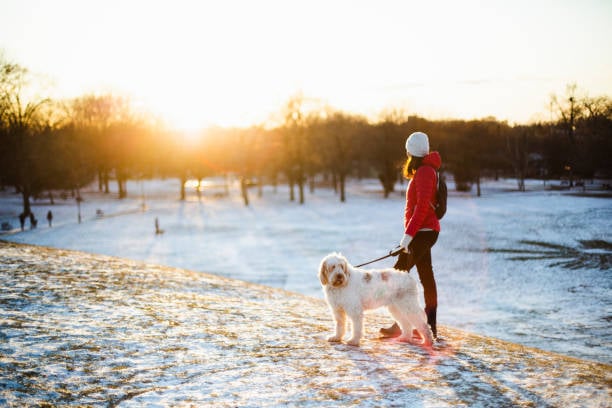Winter wonderlands are magical to experience, but these snowy conditions can also present unique challenges for our furry friends.
Whether you're a pet parent planning a snowy adventure or a pet-care business caring for dogs in colder months, keeping safety in mind ensures the experience remains fun and stress-free! Below are five key considerations for safeguarding dogs during snowy weather.
Protect Those Paws
 Paw pads on dogs are sensitive and can be easily irritated by ice, snow, and salt. Preventative measures are essential, like:
Paw pads on dogs are sensitive and can be easily irritated by ice, snow, and salt. Preventative measures are essential, like:
- Boots: Invest in high-quality dog boots to shield paws from freezing temperatures and harmful chemicals.
- Paw Balm: Apply a paw balm or wax before walks to create a barrier between their pads and the ground.
- Post-Walk Care: After outdoor play, wash your dog’s paws with warm water to remove debris, salt, or ice.
This simple care routine keeps your dog's paws safe and reduces the risk of injuries or infections.
Dress for the Weather
While some breeds are naturally equipped for cold weather, others (we're looking at you: single-coated dogs!) may need extra layers to stay warm.
Smaller dogs, senior dogs, and those with short coats are more susceptible to the cold. Outfit them with:
- Insulated jackets or sweaters
- Waterproof coats for extra protection against wet snow
As a pet-care business, keeping a stock of various-sized winter wear can help ensure all your canine clients are comfortable during their stay.
Watch for Hypothermia and Frostbite
 Dogs can suffer from frostbite and hypothermia if exposed to extreme cold for too long. Watch for signs such as shivering, lethargy, or pale, cold extremities.
Dogs can suffer from frostbite and hypothermia if exposed to extreme cold for too long. Watch for signs such as shivering, lethargy, or pale, cold extremities.
Prevent these conditions by:
- Limiting time outdoors during freezing weather
- Ensuring access to a warm shelter at all times
- Drying dogs thoroughly after exposure to snow
By monitoring their body language and knowing the warning signs, you can act quickly if they seem unwell.
Maintain Visibility in Low Light
Winter days are short, and snow-covered landscapes can reduce visibility. Help your dog stay safe and visible during early morning or evening walks.
Equip them with:
- Reflective harnesses or jackets
- LED collars or leash attachments
- Bright-colored gear to stand out against the snow
For pet-care businesses, offering visibility gear rentals or including it in walk packages is a thoughtful touch that builds trust with clients.
Monitor Snow-Related Hazards
 Snow brings a few hidden dangers that can catch even the most prepared dog guardians off guard:
Snow brings a few hidden dangers that can catch even the most prepared dog guardians off guard:
- Ice: Slippery surfaces increase the risk of injuries for dogs and their handlers.
- Salt and Chemicals: De-icing products can irritate paws and cause digestive issues if ingested.
- Hidden Objects: Snow can conceal sharp objects, holes, or other hazards that could harm your dog.
Pet parents and pet-care providers should always supervise outdoor play and avoid unfamiliar or hazardous areas.
Snowy weather can provide endless fun for dogs, but staying vigilant about their health and safety ensures those moments remain joyful. With the right precautions, you can enjoy frosty days without worry!
Ready to elevate your pet-care game? Get a Gingr demo today and keep clients happy year-round!
Subscribe to the Gingr Blog






